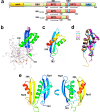INI1/SMARCB1 Rpt1 domain mimics TAR RNA in binding to integrase to facilitate HIV-1 replication
- PMID: 33980829
- PMCID: PMC8115288
- DOI: 10.1038/s41467-021-22733-9
INI1/SMARCB1 Rpt1 domain mimics TAR RNA in binding to integrase to facilitate HIV-1 replication
Abstract
INI1/SMARCB1 binds to HIV-1 integrase (IN) through its Rpt1 domain and exhibits multifaceted role in HIV-1 replication. Determining the NMR structure of INI1-Rpt1 and modeling its interaction with the IN-C-terminal domain (IN-CTD) reveal that INI1-Rpt1/IN-CTD interface residues overlap with those required for IN/RNA interaction. Mutational analyses validate our model and indicate that the same IN residues are involved in both INI1 and RNA binding. INI1-Rpt1 and TAR RNA compete with each other for IN binding with similar IC50 values. INI1-interaction-defective IN mutant viruses are impaired for incorporation of INI1 into virions and for particle morphogenesis. Computational modeling of IN-CTD/TAR complex indicates that the TAR interface phosphates overlap with negatively charged surface residues of INI1-Rpt1 in three-dimensional space, suggesting that INI1-Rpt1 domain structurally mimics TAR. This possible mimicry between INI1-Rpt1 and TAR explains the mechanism by which INI1/SMARCB1 influences HIV-1 late events and suggests additional strategies to inhibit HIV-1 replication.
Conflict of interest statement
The authors declare no competing interests.
Figures








Similar articles
-
TAR RNA Mimicry of INI1 and Its Influence on Non-Integration Function of HIV-1 Integrase.Viruses. 2025 May 11;17(5):693. doi: 10.3390/v17050693. Viruses. 2025. PMID: 40431704 Free PMC article. Review.
-
Protein-Protein and Protein-RNA Interaction Assays to Determine Similarity of INI1/SMARCB1 and TAR RNA in Binding to HIV-1 Integrase.Methods Mol Biol. 2023;2610:85-97. doi: 10.1007/978-1-0716-2895-9_8. Methods Mol Biol. 2023. PMID: 36534284
-
Computational modeling of Repeat1 region of INI1/hSNF5: An evolutionary link with ubiquitin.Protein Sci. 2016 Sep;25(9):1593-604. doi: 10.1002/pro.2961. Epub 2016 Jun 27. Protein Sci. 2016. PMID: 27261671 Free PMC article.
-
An Essential Role of INI1/hSNF5 Chromatin Remodeling Protein in HIV-1 Posttranscriptional Events and Gag/Gag-Pol Stability.J Virol. 2016 Oct 14;90(21):9889-9904. doi: 10.1128/JVI.00323-16. Print 2016 Nov 1. J Virol. 2016. PMID: 27558426 Free PMC article.
-
Going beyond Integration: The Emerging Role of HIV-1 Integrase in Virion Morphogenesis.Viruses. 2020 Sep 9;12(9):1005. doi: 10.3390/v12091005. Viruses. 2020. PMID: 32916894 Free PMC article. Review.
Cited by
-
The C-Terminal Domain of HIV-1 Integrase: A Swiss Army Knife for the Virus?Viruses. 2022 Jun 27;14(7):1397. doi: 10.3390/v14071397. Viruses. 2022. PMID: 35891378 Free PMC article. Review.
-
Retrointegration2023-Papers from the 7th International Conference on Retroviral Integration.Viruses. 2025 Jun 23;17(7):879. doi: 10.3390/v17070879. Viruses. 2025. PMID: 40733497 Free PMC article.
-
Enhancing RNA 3D Structure Prediction in CASP16: Integrating Physics-Based Modeling With Machine Learning for Improved Predictions.Proteins. 2025 Jun 9:10.1002/prot.26856. doi: 10.1002/prot.26856. Online ahead of print. Proteins. 2025. PMID: 40488225
-
Quinolinonyl Derivatives as Dual Inhibitors of the HIV-1 Integrase Catalytic Site and Integrase-RNA interactions.ACS Med Chem Lett. 2024 Aug 5;15(9):1533-1540. doi: 10.1021/acsmedchemlett.4c00268. eCollection 2024 Sep 12. ACS Med Chem Lett. 2024. PMID: 39291012
-
Emergence of Compensatory Mutations Reveals the Importance of Electrostatic Interactions between HIV-1 Integrase and Genomic RNA.mBio. 2022 Oct 26;13(5):e0043122. doi: 10.1128/mbio.00431-22. Epub 2022 Aug 17. mBio. 2022. PMID: 35975921 Free PMC article.
References
Publication types
MeSH terms
Substances
Grants and funding
LinkOut - more resources
Full Text Sources
Other Literature Sources

